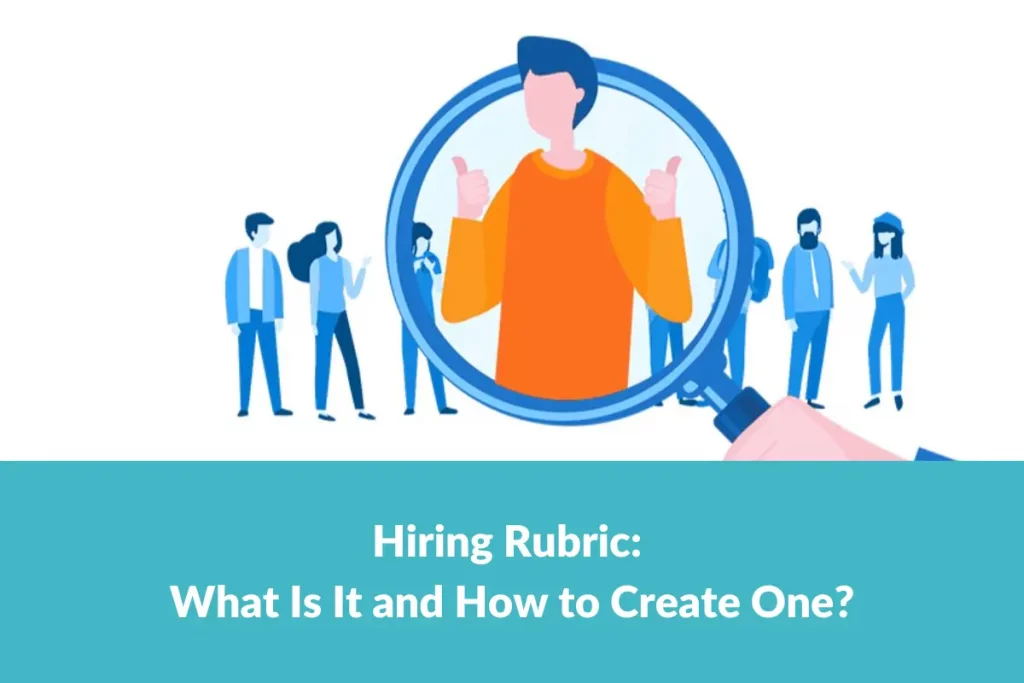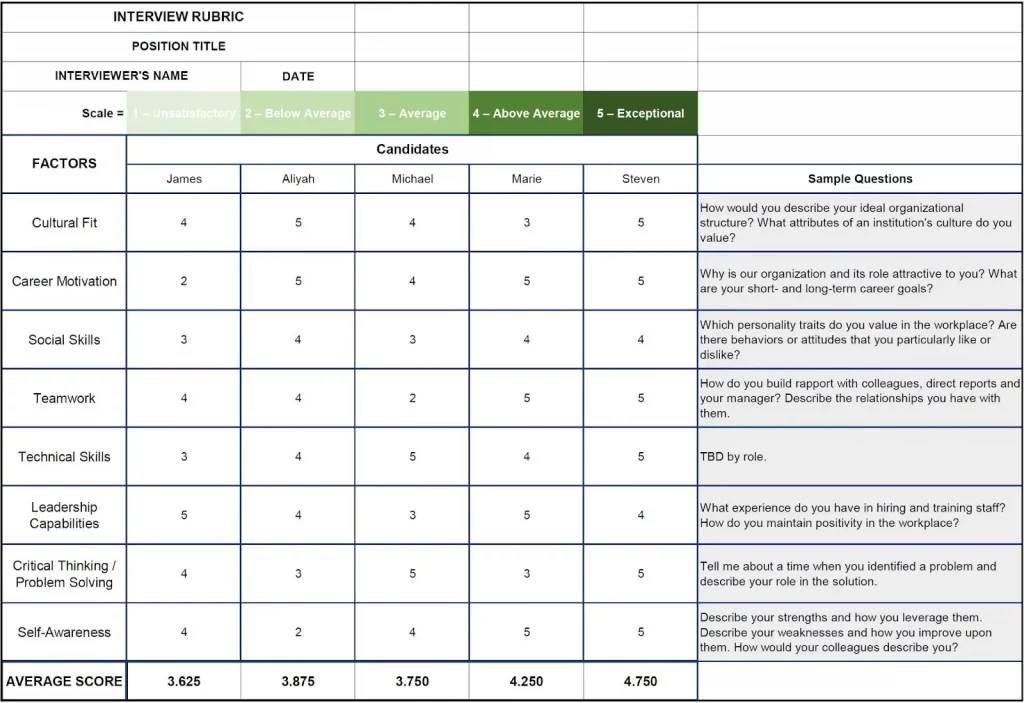Hiring an employee can be a daunting task. There are many things to consider, from the job requirements to the company culture. One tool that can help make the process easier is a hiring rubric.
Creating a hiring rubric is an essential part of the hiring process and recruitment funnel. It helps to ensure that you are looking for the right candidates, and it also makes the process more efficient and fair. In this blog post, we will discuss what a hiring rubric is and how to create one.
What is a hiring rubric?
A hiring rubric is a scoring tool that defines the expectations used to evaluate each candidate. By using a hiring rubric, also known as a hiring matrix or hiring scorecard, each person in a group discussion can participate equally in assessing candidates.

A rubric helps you determine who to interview, who to invite for a second round, and who to offer the job. As a result, search committees or hiring teams may use an applicant screening rubric in addition to an interview hiring rubric.
Why Hiring Rubrics Improve Fairness and Accuracy
Regarding hiring, rubrics can be a valuable tool in assessing candidates. They can help to standardize the evaluation process by making it fair and consistent.
Additionally, they can help identify candidates’ strengths and weaknesses, allowing for better decision-making. When designing a rubric for hiring, it is important to consider the specific criteria used to assess candidates.

You should consider some common factors, including:
- Education and experience
- Skills and abilities
- Competencies
- Attitude and interpersonal skills
- Work ethic
- Motivation
You can break each of these factors down into more specific criteria. For example, when assessing a candidate’s education and experience, you may consider their degree level, the relevance of their work experience, and the quality of their references.
As you develop your hiring rubric, remember that it should be tailored to the specific job you are hiring for. This approach ensures that you consider only the most qualified candidates.
How Rubrics Reduce Bias in Hiring
Unstructured interviews are particularly vulnerable to unconscious bias. For example, interviewers often lean on “gut feel” or favor candidates who remind them of themselves, whether through shared backgrounds, similar communication styles, or even hobbies. As a result, even strong candidates can be unintentionally overlooked.
In contrast, a hiring rubric reduces this risk by shifting the focus from subjective impressions to observable, job-related behaviors and skills. With this approach, every candidate is asked the same core questions, evaluated against the same criteria, and scored on the same scale. Consequently, this consistency minimizes the influence of factors like gender, race, or personality traits unrelated to performance.
Most importantly, research shows that structured interviews are more than twice as predictive of job success compared to unstructured interviews (validity coefficient of .63 vs. .20). Therefore, by applying hiring rubrics, companies create a level playing field that increases fairness, improves transparency, and inclusion goals.
The Benefits of Structured Interview Scorecards
A structured interview scorecard takes the concept of a hiring rubric a step further by providing interviewers with a standardized template for evaluation and scoring. Instead of walking into an interview with a blank notepad, hiring teams have a clear framework that keeps the conversation focused on what matters most.
The benefits are significant, and they include:
- First, consistency across interviewers: Whether one person or a panel is conducting interviews, everyone scores candidates using the same criteria. As a result, this makes outcomes easier to compare and discuss.
- Second, improved decision-making: Rather than relying on vague impressions (“I liked them” or “They seemed confident”), scorecards provide quantifiable data tied directly to role requirements.
- Third, efficiency in debriefs: Post-interview discussions become faster and more productive because feedback is anchored in measurable categories.
- Fourth, defensibility and transparency: If a candidate questions the decision, companies can point to the scorecard to show exactly how evaluations were made. This strengthens the employer brand and builds trust.
- Finally, better candidate experience: Structured processes demonstrate professionalism and fairness, which matter to today’s job seekers — particularly Millennials and Gen Z.
Ultimately, structured interview scorecards help companies make smarter, fairer, and faster hiring decisions, while at the same time protecting against costly mis-hires.
How to Create a Hiring Rubric (Step by Step)
Creating a hiring rubric doesn’t have to be complicated — but it does need to be deliberate and structured. By following a clear framework, you can ensure your rubric captures the skills, values, and behaviors that truly predict success. Here’s how to get started:
Define the Skills and Competencies That Matter
The foundation of any effective hiring rubric is identifying what actually drives success in the role. Start by asking:
- What technical skills are essential (e.g., coding proficiency, data analysis, campaign planning)?
- Which core competencies matter most (e.g., problem-solving, adaptability, leadership)?
- What values and cultural traits does your team prioritize (e.g., collaboration, accountability, innovation)?
It helps to separate these into must-have criteria (non-negotiables) and differentiators (qualities that would make someone truly stand out). For example, a marketing manager might need campaign planning and analytics as must-haves, while “revenue-driven strategy” could be a differentiator.
By being intentional here, you ensure you’re measuring what matters — not just what feels impressive in the moment.
Set Clear Scoring Criteria for Consistency
Once you know what to measure, define how you’ll measure it. A typical hiring rubric uses a 1–5 scale, but the key is to add descriptions for each score so that ratings are consistent across interviewers.
Example for Collaboration:
- 1 – Poor: Avoids collaboration; prefers working in isolation.
- 3 – Average: Works well in teams but needs occasional guidance to stay aligned.
- 5 – Excellent: Proactively collaborates, builds strong relationships, and elevates team performance.
This clarity prevents subjective interpretation (“I thought they were a 4 because I liked their vibe”) and ensures interviewers evaluate behavior against defined benchmarks.
Calibrate Your Interview Team for Alignment
Even with a strong hiring rubric, different interviewers can interpret scores differently. That’s where calibration comes in.
Before launching your rubric:
- Run a mock interview or two where multiple interviewers score the same candidate.
- Compare results and discuss discrepancies. For example, if one person scores “problem-solving” as a 2 and another gives it a 4, clarify what evidence each looked for.
- Adjust your scoring definitions until the team agrees on what each rating truly represents.
This step ensures inter-rater reliability, meaning multiple interviewers will reach similar conclusions when evaluating the same candidate. The result? Faster debriefs, fairer decisions, and stronger confidence in your final hire.
👉 Together, these steps create a hiring rubric that’s reliable, fair, and predictive of success — the opposite of gut-driven, inconsistent interviews.
Hiring Rubric Examples and Templates
Hiring rubrics take on different forms in different interview settings. In blind hiring, the interviewer does not see the candidate’s resume or other identifying information. Employers often use this type of interview to assess a candidate’s skills rather than qualifications.

Here are the formats to consider:
Job Application Screening Rubric
By creating an application screening rubric, you streamline the structured hiring process and benefit both employers and job seekers. Employers uphold company standards while ensuring hiring managers spend time only on candidates most likely to succeed. Job seekers benefit from a fair, consistent evaluation process that focuses on skills and minimum qualifications instead of bias or guesswork.
At this stage, an application rubric usually emphasizes broader, role-specific criteria—such as degree requirements, certifications, or years of experience—before moving to more detailed competencies in an interview rubric. This step helps recruiters identify qualified candidates quickly and maintain an equitable hiring process.
Phone Interview Rubric
When it comes to phone interviews, the phone interview hiring rubric is an essential tool. It keeps the interviewer focused on the specific needs of the role. This interview allows employers to ask questions and get to know a job applicant prior to the more time-intensive in-person meeting. While this can be a great way to save time and money, it can also be tricky to get a true sense of a candidate over the phone. The structured phone interview rubric ensures that each applicant is evaluated from the same set of criteria.
In-Person or Video Interview Rubric
Personal interviews can be an essential part of the hiring process. This is your chance to meet with potential employees face-to-face and get to know them personally. In certain situations, a video interview will have to do, however.

Panel Interview Rubric
If you’re looking for a way to add an extra level of objectivity to your group interviews, consider using an evaluation board. By bringing in multiple viewpoints, you can ensure that all candidates are getting a fair shake and that the person who ultimately gets the job is the most suitable candidate.
Hiring rubric sample template
Below is a sample hiring rubric you can use as a guide when creating your own. This rubric can be customized to fit the specific needs of your company, department, and role.
|
Qualifications |
Work experience |
Personal Characteristics |
Communication skills |
|
Does the candidate have the necessary qualifications for the job? |
Does the candidate have relevant work experience for the job? |
Is the candidate friendly and personable? |
Is the candidate’s communication clear and concise? |
|
Are the candidate’s qualifications relevant to the job? |
Is the candidate’s work experience verified? |
Is the candidate respectful and professional? |
Does the candidate listen well and ask questions when appropriate? |
|
Are the candidate’s qualifications verified? |
Does the candidate’s work experience demonstrate their ability to do the job? |
Does the candidate have a positive attitude? |
Is the candidate able to articulate their thoughts and ideas effectively? |
Final Interview Scoring
The final interview is usually the last step in the hiring process. During the final interview, recruiters must learn about the candidate’s experience, goals, and reasons for being a good fit for the job.
Each interviewer’s score will be pulled together post-interview to create an overall impression of the candidate.
Here is what the final evaluation could look like when deciding between multiple candidates. The value in having the interviewer’s feedback recorded is that if you have another position open up, you can review the candidates that applied in the past, who showed to be a strong fit, and more quickly fill the role. As you can see, by applying a score to each trait, you quickly identify your top candidate.

FAQ: Hiring Rubrics and Structured Interviews
Q1: What is a hiring rubric in HR?
A hiring rubric is a structured scoring system that helps employers evaluate candidates against consistent, job-related criteria. It reduces bias and improves hiring accuracy.
Q2: Why should companies use hiring rubrics?
Hiring rubrics ensure fairness, consistency, and data-driven decisions. Research shows structured interviews are more than twice as predictive of job success compared to unstructured interviews.
Q3: How do I create a hiring rubric for interviews?
To create a rubric, define must-have skills, cultural values, and standout traits for the role. Then assign scoring ranges (e.g., 1–5) with clear descriptions so interviewers can rate candidates objectively.
Q4: Can AI improve hiring rubrics?
Yes. AI can automatically generate custom rubrics from job descriptions, analyze historical hiring data, and link rubric scores to employee performance for better long-term hiring outcomes.
Q5: What are examples of hiring rubric criteria?
Common criteria include education, technical skills, leadership ability, communication, problem-solving, and alignment with company values. These can be customized per role.
Q6: Are hiring rubrics useful for small businesses or startups?
Absolutely. Rubrics save time, improve consistency, and help smaller teams avoid costly mis-hires by standardizing the evaluation process.
AI-Powered Hiring Rubrics: The Future of Recruiting
As talent acquisition evolves, AI-powered hiring rubrics are emerging as the next frontier in fair, efficient recruiting. Here’s how cutting-edge technology is reshaping the process.
How AI Automates Rubric Creation
Gone are the days when building hiring rubrics meant endless spreadsheet editing and team back-and-forth. Today, AI takes on the heavy lifting:
- Tools like Boulo’s Interview Rubric Builder can analyze your job description and instantaneously generate a hiring rubric tailored to that role’s must-have skills, values, and standout traits Boulo Solutions.
- AI Hiring Rubric Generators in other industries—like education—demonstrate similar capabilities, using natural language processing to craft clear, fair, and effective frameworks from minimal input Alayna AI and Toolify.
In short, AI transforms the rut of hiring rubric creation into a streamlined, intelligent workflow—saving hours while preserving precision.
Using Predictive Analytics to Link Scores to Performance
AI doesn’t just help build your hiring rubric—it ensures it evolves into a performance engine:
- Predictive analytics in hiring allows AI systems to identify patterns between candidate scores and actual on-the-job success, including retention and performance metrics ai-recruitment.co techtree.dev.
- Modern ATS platforms using these data models show tangible results—85% better hiring success, with 25% reduced time-to-fill and 30% improved retention over traditional methods Talent Business Partners.
These insights shift hiring from gut-driven guesses to strategic, evidence-based decisions with measurable business impact.
ATS Integration and Data-Driven Insights
True transformation happens when AI meets your hiring ecosystem:
- Platforms like IBM show how AI paired with structured data can streamline tasks—from resume parsing to onboarding—while supporting diversity-driven decision-making IBM.
- Solutions like Canditech exemplify how AI assessments and hiring rubrics can be embedded directly into ATS workflows, offering auto-generated tests, AI scoring, analytics dashboards, and seamless integration with systems like Lever, Greenhouse, Workable, and more Wikipedia.
By aligning AI hiring rubrics with your ATS, you gain a unified, scalable, and data-enriched hiring engine.
Ready to Dive Deeper?
Want to explore these concepts further and see how AI hiring rubrics are changing the game? Check out our full article:
Why AI-Driven Rubrics Are the Future of Hiring
Conclusion: Why Every Company Needs an AI-Powered Hiring Rubric
Hiring is too important to leave to chance. A structured hiring rubric ensures that every candidate is evaluated against clear, job-relevant criteria, reducing bias and improving decision quality. Instead of relying on gut feel, you’ll have measurable evidence that supports smarter, faster, and fairer hires.
Now you have two powerful paths forward:
- Create your own rubric by following the step-by-step framework we outlined — define the must-have skills, set clear scoring criteria, and calibrate your team for alignment.
- Or, save time with Boulo’s free AI Interview Rubric Builder, which generates a customized, bias-aware scorecard for you in minutes. Simply paste your job description, answer three quick questions, and download a rubric you can use in your very next interview.
Either way, adopting hiring rubrics moves your hiring process from instinct to intelligence. And in today’s competitive market, that’s not just a best practice — it’s a strategic advantage.
👉 Try Boulo’s AI Interview Rubric Builder now and see how easy it is to hire with clarity and confidence.
The rubric can be used to score responses to questions and employees’ overall impressions during the interview.
References
- Sian Brannon, Julie Leuzinger. (2014). Keeping Human Resources happy: improving hiring processes through the use of rubrics. Denton: Pixey Mosley. Retrieved from https://diversity.med.wustl.edu/wp-content/uploads/2018/05/Keeping-Human-Resources-Happy.pdf
- Smartsheet. (2018). JOB INTERVIEW RUBRIC TEMPLATE. Smartsheet. Retrieved from https://www.smartsheet.com/sites/default/files/IC-Job-Interview-Rubric-9410_PDF.pdf

